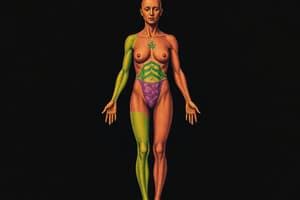Podcast
Questions and Answers
What are the primary functions of epithelial tissue?
What are the primary functions of epithelial tissue?
The primary functions of epithelial tissue are protection, absorption, secretion, and filtration.
Describe the difference between dense connective tissue and loose connective tissue.
Describe the difference between dense connective tissue and loose connective tissue.
Dense connective tissue provides strength and structure, while loose connective tissue offers flexibility and support.
What are the main types of muscle tissue, and how do they differ in function?
What are the main types of muscle tissue, and how do they differ in function?
The main types of muscle tissue are skeletal (voluntary and striated), cardiac (involuntary and striated), and smooth (involuntary and non-striated).
What is the role of the extracellular matrix (ECM) in tissues?
What is the role of the extracellular matrix (ECM) in tissues?
Identify the types of epithelial tissue and their basic characteristics.
Identify the types of epithelial tissue and their basic characteristics.
Explain the regenerative abilities of nervous tissue compared to epithelial tissue.
Explain the regenerative abilities of nervous tissue compared to epithelial tissue.
What distinguishes cardiac muscle tissue from skeletal muscle tissue?
What distinguishes cardiac muscle tissue from skeletal muscle tissue?
How are different tissue types organized to form organs?
How are different tissue types organized to form organs?
Flashcards are hidden until you start studying
Study Notes
Types of Tissue
-
Epithelial Tissue
- Covers body surfaces and lines cavities.
- Functions: protection, absorption, secretion, filtration.
- Types:
- Simple squamous: single layer of flat cells.
- Cuboidal: cube-shaped cells.
- Columnar: tall, column-like cells.
- Stratified: multiple cell layers for protection.
- Transitional: specialized for stretching (e.g., bladder).
-
Connective Tissue
- Supports, binds, and protects other tissues and organs.
- Key components: cells, fibers, ground substance.
- Types:
- Loose connective: provides flexibility and support (e.g., adipose).
- Dense connective: strong, provides structure (e.g., tendons, ligaments).
- Cartilage: flexible support (e.g., hyaline, elastic, fibrocartilage).
- Bone: rigid, provides structural support and protection.
- Blood: fluid connective tissue involved in transport.
-
Muscle Tissue
- Responsible for movement.
- Types:
- Skeletal muscle: voluntary, striated, multinucleated.
- Cardiac muscle: involuntary, striated, branched, single nucleus.
- Smooth muscle: involuntary, non-striated, single nucleus.
-
Nervous Tissue
- Composed of neurons and glial cells.
- Neurons: specialized for transmitting electrical signals.
- Glial cells: support and protect neurons.
Tissue Structure
-
Cell Types
- Varies based on tissue type (e.g., epithelial cells, muscle fibers).
- Specialized functions (e.g., absorption, contraction).
-
Extracellular Matrix (ECM)
- Composed of proteins and extracellular components.
- Provides structural and biochemical support to surrounding cells.
- Components:
- Fibers (collagen, elastin).
- Ground substance (proteoglycans, glycoproteins).
-
Tissue Organization
- Tissues are organized into organs.
- Each tissue type plays a specific role in organ function.
- Involves interactions between different tissue types (e.g., muscle and nervous tissue in heart).
-
Regeneration and Repair
- Some tissues (e.g., epithelial and connective) can regenerate.
- Others (e.g., nervous tissue) have limited regenerative abilities.
Epithelial Tissue
- Covers body surfaces and lines cavities.
- Functions include protection, absorption, secretion, and filtration.
- Simple squamous tissue: single layer of flat cells, found in areas of diffusion and filtration.
- Cuboidal tissue: cube-shaped cells, found in glands and ducts.
- Columnar tissue: tall, column-like cells, found in lining of digestive tract, responsible for absorption and secretion.
- Stratified tissue: multiple cell layers, provides protection.
- Transitional tissue: specialized for stretching, found in urinary bladder.
Connective Tissue
- Supports, binds, and protects other tissues and organs.
- Key components: cells, fibers, and ground substance.
- Loose connective tissue: provides flexibility and support, found in subcutaneous layer.
- Dense connective tissue: strong and provides structure, found in tendons and ligaments.
- Cartilage: flexible support, found in joints, trachea, and ears.
- Bone: rigid, for structural support and protection.
- Blood: fluid connective tissue involved in transport of nutrients and oxygen.
Muscle Tissue
- Responsible for movement.
- Skeletal muscle: voluntary, striated, multinucleated, responsible for movement of bones.
- Cardiac muscle: involuntary, striated, branched, single nucleus, found in heart.
- Smooth muscle: involuntary, non-striated, single nucleus, found in walls of internal organs.
Nervous Tissue
- Composed of neurons and glial cells.
- Neurons: specialized for transmitting electrical signals.
- Glial cells: support and protect neurons.
Cell Types
- Vary based on tissue type.
- Specialized functions based on cell type.
Extracellular Matrix (ECM)
- Composed of proteins and extracellular components.
- Provides structural and biochemical support to cells.
- Components include fibers (collagen, elastin) and ground substance (proteoglycans, glycoproteins).
Tissue Organization
- Tissues are organized into organs.
- Each tissue type plays a specific role in organ function.
- Involves interactions between different tissue types.
Regeneration and Repair
- Some tissues (e.g., epithelial and connective) can regenerate.
- Others (e.g., nervous tissue) have limited regenerative abilities.
Studying That Suits You
Use AI to generate personalized quizzes and flashcards to suit your learning preferences.



